Cataract
Cataract is the leading cause of preventable blindness in the world. 80% of the blindness in India is due to cataract.
Cataract is mainly seeing in aged person around 50 years old or above , in one or both eyes. Some times seen in children at birth is called congenital Cataract. In some cases due to penetrating and blunt Injury also leads to cataract.
Symptoms are haziness ,blurred and double vision, sensitivity to light and glare, difficulty seeing in poor lighting conditions and changes in contrast sensitivity, colour fading.
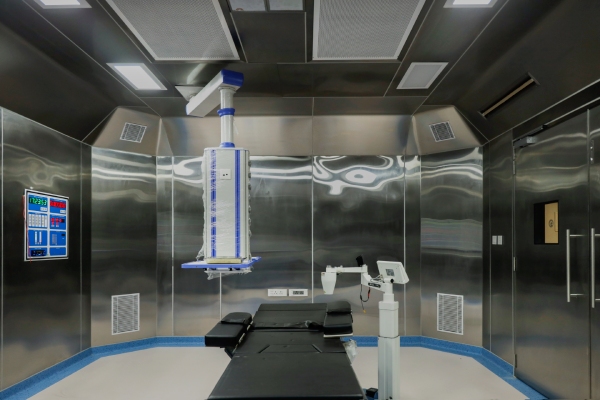
SS Theater with Laminar Flow
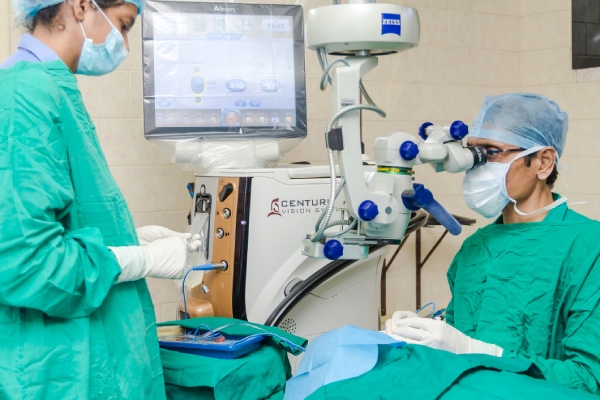
Cataract eye surgery is the only treatment for cataract in world wide , 2.2 mm incision Phaco Emulsification with Intra Ocular Lens Implantation are the most advanced cataract removal method ,Some times Small Incision Cataract Surgery will do in Hyper Mature Cataract . The world wide best Phaco emulsification machine Alcon Centurian Gold star is available in Kollam district only at Shankars eye hospitals (are the best eye hospitals in kollam district)
Cataract Department Services
- Proficient technology to take IOL power calculation, preoperative evaluation, and in the operation theatre
- Dedicated and skilled team of Optometrists and Nurses for pre-operative evaluation
- Concept and technology planning for super speciality cataract surgery
- To equip the efficient cataract surgeon with skills to manage challenging cases and aim for the best visual outcomes
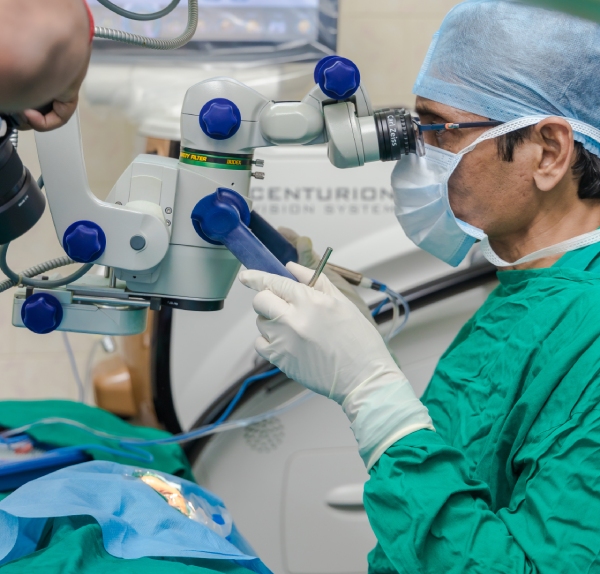
Surgical Techniques Available at Shankar’s Eye Hospitals (the best eye hospitals in kollam district)
Shankars eye hospitals , offers various advanced, cutting-edge surgical techniques to treat cataract. Based on the Cataract Grade, health condition, working environment and lifestyle, the Surgeon will recommend the best suitable options. The three commonly used surgical techniques are:
Small Incision Cataract Surgery (SICS)
This is also an old technique where the cataract is removed manually through a slightly larger incision. Mainly doing for hyper mature cataract.
Phacoemulsification
Phacoemulsification is the small incision (2.4 mm to 2.8 mm)cataract surgery wherein a machine is used to emulsify (break down and remove) the cataract with a special probe that utilizes ultrasound energy. smaller incision size results in lesser astigmatism and thus better quality of vision for the patient. A foldable intra ocular lens is implanted after the emulsification of the nucleus. This surgery is performed under Topical Anaesthesia as a daycare procedure following which the patient is free to go home. This is a painless and modern cataract surgery technique that offers quick healing and cataract surgery recovery.
MICS (Micro Incision Cataract Surgery)
MICS (Micro Incision Cataract Surgery) is the most advanced cataract surgery, the standard phacoemulsification is performed with an incision size of 2.2 mm. The smaller incision size in this procedure as compared to the standard phacoemulsification has the benefit of faster healing and induces lesser astigmatism. The patient can lead the normal life soon.
Cataract Surgery Lens Options
Monofocal Lens
With traditional cataract surgery, you will receive a standard monofocal lens that will provide good distance vision, but you will still need glasses for close and possibly for intermediate vision.
Astigmatism-Correcting Lens
If you have astigmatism and choose cataract surgery with an astigmatism-correcting monofocal lens, you will eliminate both cataracts and astigmatism but will still need glasses for improved vision.
Multifocal/Accommodative Lens
With cataract surgery, a multifocal/accommodative lens can improve near, far, and intermediate vision, allowing most patients to function with little need for glasses.
Extended Depth of Focus (EDOF) IOLs
Extended Depth of Focus (EDOF or EDF), or Extended Range of Vision, is a new technology that has recently emerged in the treatment of Presbyopia-correcting IOLs. In contrast to multifocal intraocular lenses (IOLs) used in treatment of presbyopia, EDOF lenses work by creating a single elongated focal point to enhance “range of vision” or “depth of focus. Both multifocal and EDOF lenses have been shown to increase levels of spectacle independence, however both lens types may be associated with unwanted photic phenomena such as glare and halos.
Special Procedures
- ACIOL
- SFIOL (Scleral Fixation IOL)
- Lensotomy
- Iris Claw IOL Implantation
- Secondary IOL Implantation
Cataract Consultation - Patient Process Flow
If you are over the age of 50 and your vision has been changing, it’s a good time to schedule an appointment with an ophthalmologist to get your eyes checked for cataract. You can come prepared for your cataract consultation by making a list of all the symptoms you are experiencing and a list of all the medications you are currently taking.
Your initial consultation will take approximately 2 hours if you do not require cross-consultation and up to 4 hours if you do. During your cataract consultation, our doctors will determine the best course of action for your vision needs, go over the risks and benefits of cataract surgery, and help you choose the procedure and lens that best suit your lifestyle, visual needs, and budget. We suggest bringing a family member or friend with you to assist with decision-making.
- You will then meet a general physician who will evaluate you for systemic illnesses such as diabetes, high blood pressure, thyroid, autoimmune diseases, or other underlying health problems that can affect the outcome of your cataract surgery.
- You will also meet a retina specialist who will dilate your eyes to examine your retina thoroughly to rule out any retinal disease.
- If you are approved for surgery, you will then meet the counselors who will extensively explain the entire cataract treatment options and cataract surgery procedure. They will also help you determine the type and power of the cataract intraocular lens (artificial lens) you need for good visual outcome post-cataract surgery. This will be based on your age, the severity of cataract vision loss, your budget, daily activities, and the type of vision (near or distance focus) you require to complete those activities. If you have pre-existing conditions such as astigmatism, glaucoma, macular degeneration, or corneal disease which affects your vision, the counselors may suggest a specific type of replacement lens that could treat both the cataract and your pre-existing condition.
- Finally, the counselors will schedule the date for your cataract surgery. They will also advise you on the pre-operative cataract medications to be taken.
- If you have health insurance for cataract surgery you can go to the hospital insurance helpdesk and fill out the necessary insurance preauthorization forms. After this, you can visit the pharmacy to purchase the prescribed pre-operative medications before going home. If you do not have health insurance for cataract surgery you can visit the pharmacy and purchase the prescribed pre-operative medications before going home.
We understand that your decision to undergo cataract surgery requires careful consideration and planning. If you have any questions about your cataract consultation or cataract surgery, please feel free to reach out to us at 9995372579 between 9 AM - 6 PM.
Detailed preoperative cataract assessment and patient counseling, advanced diagnostic equipment, state-of-the-art operation theatre complex, renowned cataract surgeons, and as leading practitioners in their field and are experienced in handling cataract cases with varying complications such as diabetes, glaucoma, hypertension, age-related macular degeneration, retinitis pigmentosa, corneal scars, trauma, childhood cataract, etc. SEH is one of the preferred choices for complicated cataract surgeries, especially post traumatic and high-risk referral patients, and those who may have previously undergone cataract removal surgery.
Pre-Operative Instructions for Cataract Surgery
WHAT SHOULD I DO PRIOR TO THE DAY OF CATARACT SURGERY?
It is important for you to follow all the cataract surgery pre op instructions given to you by your doctor. Your surgeon may advise you not to drink alcohol for 12 hours before the cataract eye surgery. If you are on other medications, your doctor may ask you to stop taking them or alter the timing of the medications prior to the cataract surgery procedure. You may be instructed to use cataract surgery pre op medications or pre cataract surgery eye drops to prevent infection. A good night’s rest is important before the day of the cataract operation.
PRE-CATARACT SURGERY EYE DROPS - SHOULD I APPLY EYE DROPS ON THE DAY OF CATARACT SURGERY?
Yes. Ensure that eye drops are applied as directed. Apply only one drop at a time to the suggested eye and give a gap of at least 15 minutes between drops. Note that your vision will be blurred after you apply Tropicacyl Plus eye drops on the day of cataract surgery procedure. Kindly take care accordingly.
Should I Carry the Pre-Cataract Surgery Eye Drops to the Hospital?
Yes. Bring the prescribed medicines and pre-cataract surgery eye drops with you to the hospital on the day of the surgery.
Can I Take My Regular Medication on the Day of Cataract Surgery?
If you are on medication for a systemic illness, please continue your regular medication unless specifically instructed otherwise by your ophthalmologist.
Can I Shave on the Day of Cataract Surgery?
Yes. You can shave on the day of cataract removal surgery.
Can I Bring an Attendant on the Day of Cataract Surgery?
Yes. You can bring one attendant over the age of 18 with you on the day of cataract eye surgery. Children and infants are not allowed.
Why Do I Need Eye Drops Before Cataract Surgery?
Starting the eye drops before cataract removal gives your eye a better chance to heal from the inflammation caused by the extraction and to fight infection.
Can I Have Breakfast on the Day of Cataract Surgery?
Yes. You should have breakfast (a normal diet) before coming for the cataract procedure.
Can I Wash My Hair on the Day of Cataract Surgery?
Yes. Please wash your hair on the day of surgery as you will not be able to do so for 1 week afterward. However, do not apply oil to your hair.
What Clothes Should I Wear on the Day of Cataract Surgery?
Wear loose, comfortable clothing, preferably a short-sleeve shirt or blouse that buttons or zips up the front, along with comfortable shoes when you come for cataract surgery.
Infrastructure
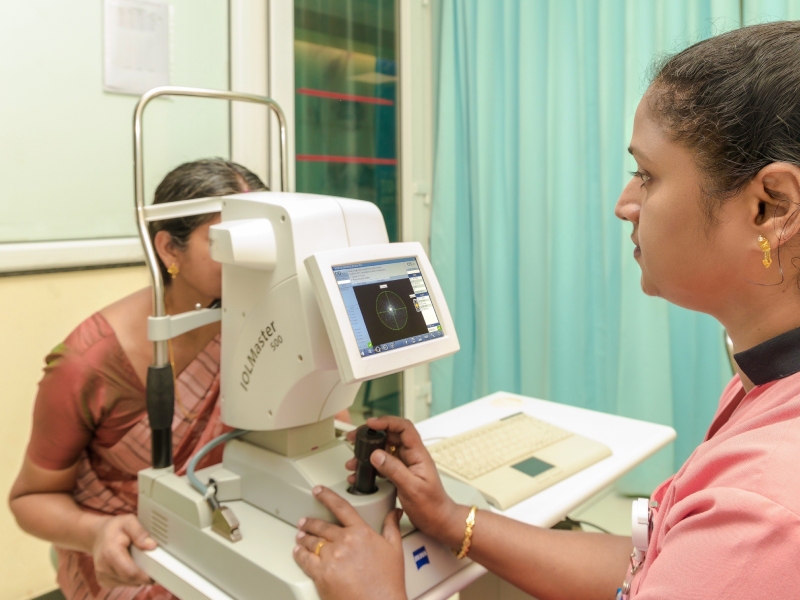
IOL Master
For accurate measurement of intraocular lens power.
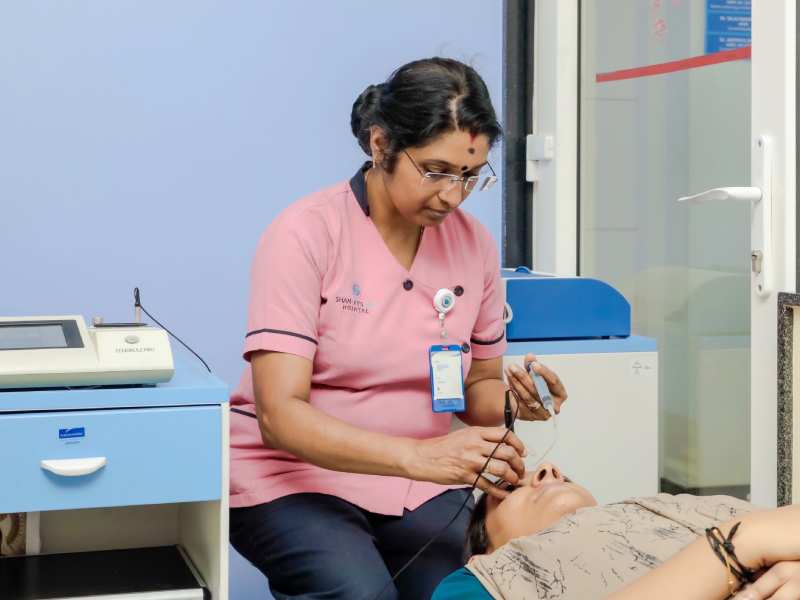
A Scan
Essential for lens power calculation before cataract surgery. The methods includes : Contact, Immersion
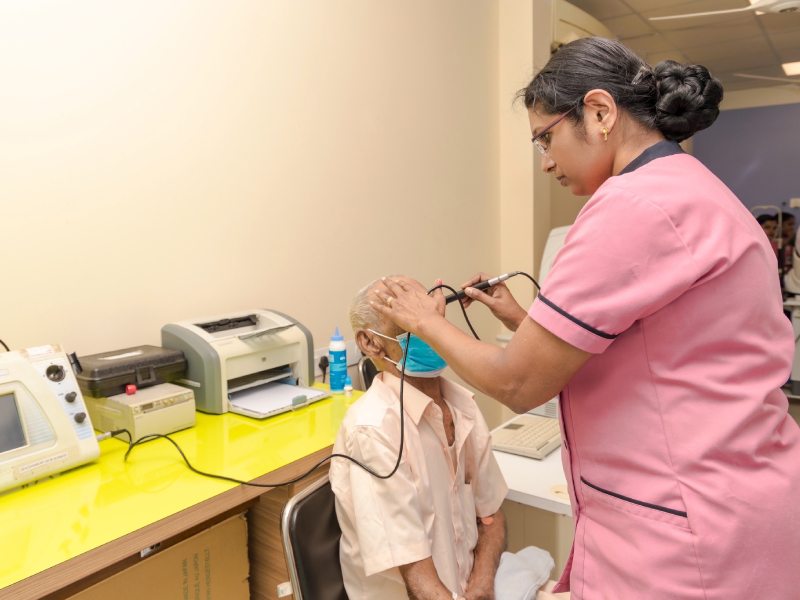
B Scan
B-scan is an ultrasound imaging technique that provides a cross-sectional view of internal structures, commonly used in ophthalmology to assess the eyes condition.
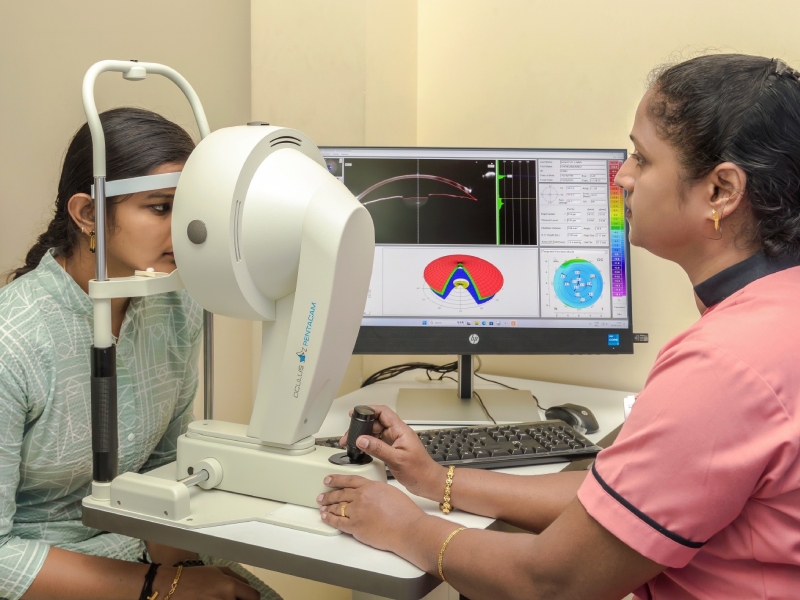
Pentacam
Provides a detailed 3D analysis of the anterior segment of the eye, crucial for diagnosing and managing corneal diseases.
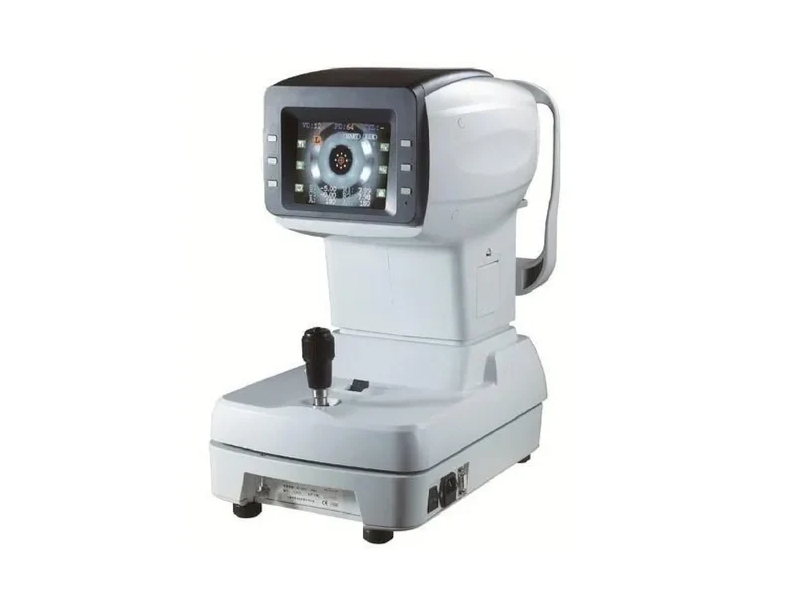
Auto Refracto Keratometer
Combines autorefraction and keratometry for a comprehensive analysis of vision and corneal curvature.
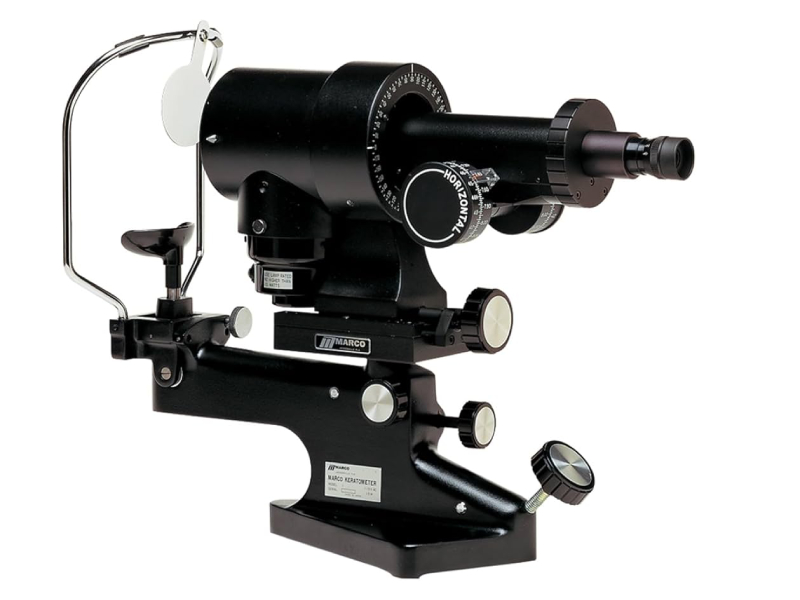
Manual Keratometer
Measures the curvature of the cornea for precise contact lens fitting and refractive surgery planning.
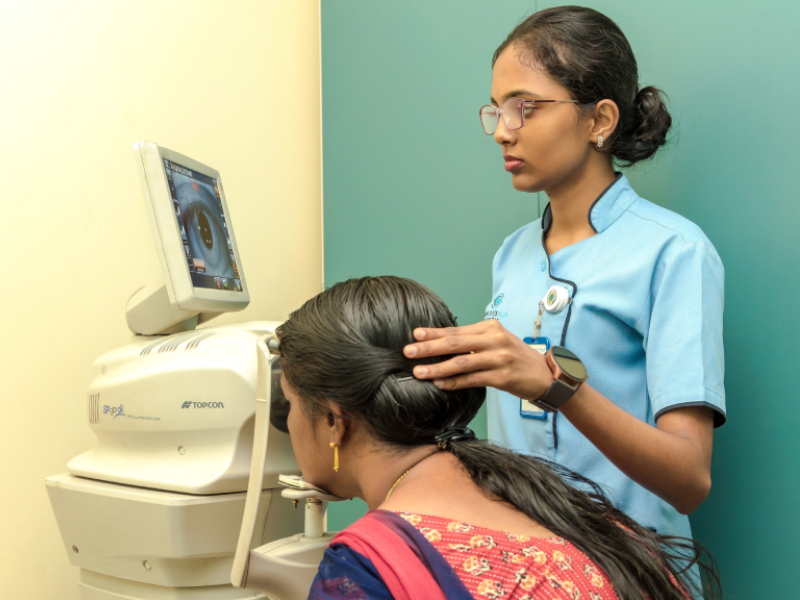
Specular Microscope
Evaluates the corneal endothelium to assess corneal health and detect early signs of disease.
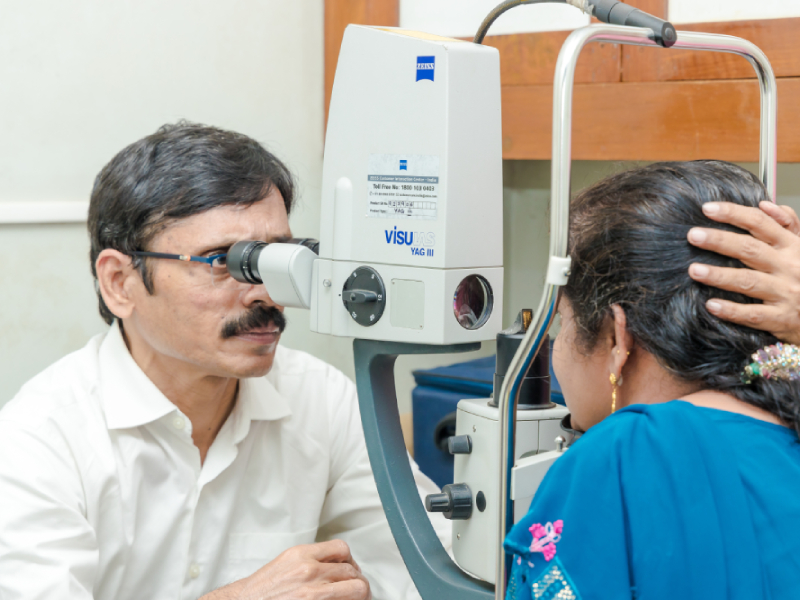
Yag Laser (Capsulotomy)
YAG Laser treatment is a highly effective, non-invasive procedure used to treat posterior capsule opacification (PCO), a common side effect that can develop after cataract surgery.
Post-Operative Instructions for Cataract Surgery
WHAT TO EXPECT AFTER CATARACT SURGERY - WILL I HAVE ANY PAIN IN MY EYE AFTER CATARACT SURGERY?
Will I Have Any Pain in My Eye After Cataract Surgery?
There is no severe pain associated with cataract removal surgery. You may experience minor discomfort, blurry vision, watering, and an itchy feeling, or slight soreness in your eye for a couple of days after surgery. While some patients do not feel major discomfort, others may feel like they have an eyelash or grain of sand in their eye. Your eye may also be slightly red after the cataract extraction. However, most recovery symptoms will settle within a few days. You can take an over-the-counter pain-relieving tablet if necessary.
Post Cataract Surgery Follow-Up
Your follow-up visits will be scheduled for 24 hours after the cataract removal, one week after the surgery, and one month after the procedure.
How Long Do I Have to Keep My Eye Covered After Cataract Surgery?
You should wear indoor protective eye glasses for 24 hours and outdoor protective glasses for 1 month after cataract surgery. It is advisable to remove your glasses while lying down or sleeping.
What Are the Usual Post Cataract Surgery Symptoms and How Soon Will They Settle?
Mild redness, a foreign body sensation, watering from both eyes, and blurred vision are common after cataract surgery. These symptoms will settle over 1-2 weeks.
Is It Safe to Take a Painkiller if I Experience Any Pain After the Cataract Surgery?
Yes, you can take a painkiller (analgesic tablet) in case of persisting pain.
How Soon Can I Go Home After the Cataract Removal Surgery?
You will need to rest in a recovery area until the effects of sedation or anesthesia wear off. This usually takes about 30 minutes to an hour. After receiving instructions on cataract surgery aftercare, you can go home.
Can I Eat Immediately After Cataract Surgery?
Yes. You may have a light snack after your cataract operation. Please carry your lunch or a snack if you are diabetic.
For How Long After Cataract Surgery Is Vision Blurry?
Some patients will experience blurred or double vision for a few days after cataract surgery. Vision will gradually begin to improve 48-72 hours after surgery. You can expect adjustments in vision to occur for a few months after cataract surgery.
What Symptoms Are Not So Common After Cataract Surgery and Need Immediate Attention?
If you experience symptoms of worsening or loss of vision, spots (floaters) or flashes in vision, increasing redness, increasing pain despite the use of pain medications, pus discharge, or persistent irritation, you need to see your doctor immediately.
Will There Be Imbalance in Vision After Cataract Surgery on the First Eye?
Yes. Since cataract surgery is only performed on one eye at a time, you may notice an imbalance in your vision after surgery on the first eye. Your vision will balance out after the second eye is operated on (1–4 weeks after surgery on the first eye).